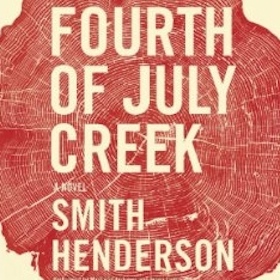'Fourth Of July Creek' By Smith Henderson: A Complex Debut Novel

4.5/5
It’s only in hindsight, say towards page two-hundred, that you realize you’re reading the great American novel. The many branches of Fourth of July Creek, the first novel from Smith Henderson, reach out along the strip of blistering cold that is rural Montana, its small town appeal carved and dissected into a nightmare for people who have lived there. They only know how to live this one life, and they’re not at all good at it. By the time you get to page two hundred you realize how far you’ve come, not only in the space of pages but in the dreary progress of the life of Pete Snow, and the string of other citizens — friends, lovers, family and clients — whose lives he has affected, and who have affected his. The pages go by like that, and it reads like a secret history of an America and a time we don’t often consider.
Pete is a social worker in 1980; his ex-wife has taken his thirteen-year-old daughter to Texas, leaving him a barely functioning alcoholic. It’s a harsh area in a harsh state, and Henderson’s prose is sharpened, blacked and jagged with sentence fragments and half-finished thoughts that are as bracing and as much a part of the rough backdrop of the story as the setting itself. Henderson’s sentences spit out tersely and strike with the same ferocity as wind-swept points of ice striking you in the face. The parlance the characters use is a twang that the narrative adopts; it’s unique and powerful without being over-wrought.
People live hard and poor out there. Their skin around the eyes and hands are rough from hard work and the elements. They are the bluest of the blue collar and each generation is terminally fated to the same tough existence, with only the rarest of circumstances. Mary, Pete’s lover and co-worker, is an example of this. She’s educated, smart, but a bit damaged and has ended up no more than twenty-five miles from where she began. Even when Henderson gives us this measure of salvation, he’s still keeping his hand wrapped around the leash. Things may get better but only incrementally and only for very few. Mary’s history and character is the most tragic yet the most fascinating. Though she’s a supporting character, she’s more than interesting enough to warrant further appearances, and, on more than one occasion, steals the spotlight as the novel’s most interesting contribution. Her story ends abruptly, like the story involving Pete’s daughter Rachel, though one ends at the other’s beginning. One can’t help but see — and Pete shows the slightest sliver of awareness as well — that Mary is Rachel’s future.
Of late, fiction has taken to stories of these hard scrapple lives. Comparisons between this work and Nick Dybek’s When Captain Flint was a Good Man or John Irving’s Last Night on Twisted River can be easily made. They all deal with similar themes and choice of terrain; the former, however, resorted to a gimmick while the latter was self-indulgent and ultimately empty. While there is a level of cartoony melodrama inherent to fiction — here, specifically, in Rachel’s story — Henderson’s writing is tighter and controlled; he writes with Dybek’s youth and Irving’s experience, but manages to avoid the pratfalls that others fell into.
Arguably, the strongest area of the novel is the careful interrogation of an unnamed character, revealing the ongoing difficulties of Pete’s teenage daughter, Rachel. She falls into the familiar trappings of sex and drugs and booze but set against the harrowing ordeals of being a runaway — rendered in a realistic dread as she continues to make bad decisions among only bad choices. She “wyoms” and experiments, and with each passing interlude the stories become more elaborate and evermore dark. The most telling and sadly poignant is Rachel’s own pretentions at being adult and sophisticated. As a teen she attempts, as any teenager does, to discover and then assert her own identity separate from her parents. She decides to take a new name — a final rejection of them — and in the contradicting result (her name is now Rose Snow) we see the prevailing character through lines: flawed thinking in flawed lives of people with contradictory desires and actions.
Pete’s desperation to find her, always remaining just a few steps behind, is palpable and jarring. His own selfishness and his demons sometimes get in the way, and great expanses of time pass between his attempts. It’s jarring, really, to find him straining all over Creation looking for her and in the next scene returning to a client or another subplot. Life does go on, of course, though the transitions are somewhat bumpy.
The novel, cover to cover, took Henderson ten years to finish. It shows. Fourth of July Creek is a labor of love and each sentence adds jagged lyricism to each thread in the tapestry. They say you need to kill your darlings for literature to work. A writer tends to love his characters, good, bad or indifferent, and it’s likely over the course of this decade-long work that Henderson couldn’t find it in his heart to truly kill his creations. Most notably, Henderson reveals his string-pulling with a particularly tidy ending concerning Pete and one of his charges. Keeping them together was a favor Henderson lent the characters and it undermines the dread and inevitability that crept into every plot and subplot.
Of course, the true thrust of the novel — Pete and his daughter — remains the true tragedy of the story, and Henderson, in that regard, scratches against the Fourth Wall as the nameless interrogator mewls at the sad and unclear answer to the question of Pete and Rachel ever seeing each other again.
This interrogation ends the story; Henderson has indicated there might be another novel that would have Rachel as its center, though his intention on ending this novel mid-sentence speaks toward the idea of the finite versus the infinite. Undoubtedly some readers will take this as a gimmick that is either as sentimental as it was when employed in Bleak House, as sensible as in The Rules of Attraction or as frustrating as in The Sopranos. In truth, the ending to Fourth of July Creek is the uncertainty of life, and how things are rarely allowed closure; some damage doesn’t get fixed; so much of it is your own fault.
GET THE FREE uINTERVIEW iPHONE APP FOR LATEST NEWS UPDATES
RELATED ARTICLES
Get the most-revealing celebrity conversations with the uInterview podcast!







Leave a comment